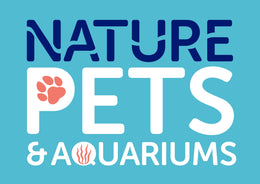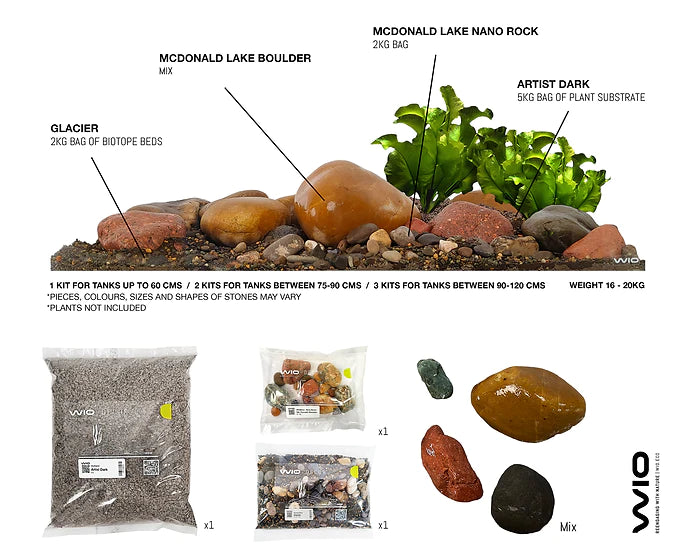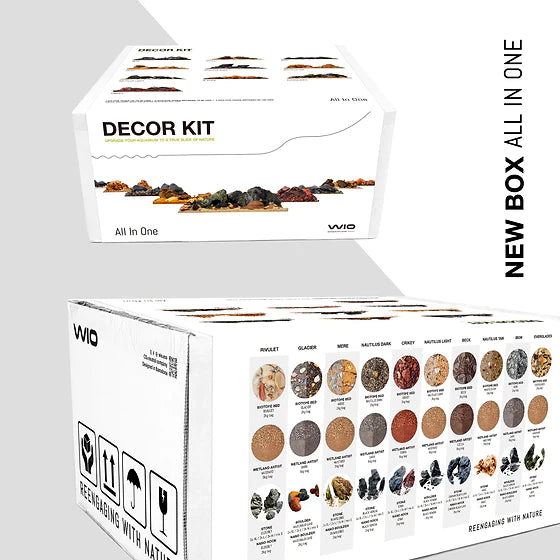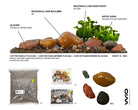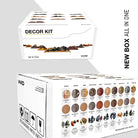Recreate the cold, natural beauty of Lake McDonald in your aquarium. The Glacier River Kit has everything you need to create a beautiful and natural aquatic environment in your aquarium.
-
Description
The Glacier River Kit is inspired by the cold, glacier waters of Lake McDonald. It is a stunningly beautiful glacier lake situated in Glacier National Park, Montana, USA. The lake is named after George Bird Grinnell's friend, Duncan McDonald, who was one of the first settlers in the area. The lake covers an area of approximately 26 square kilometers (10 square miles) and 144meter deep (472 feet), making it one of the largest and deepest lakes in the park.
The lake's clear, turquoise waters are fed by glacial meltwater, giving it a distinctive blue-green color. The pebbles found in Glacier Lake McDonald have a variety of colors, ranging from white to black, with shades of grey, pink, and green in between. These pebbles have been formed over thousands of years by the erosion of the surrounding mountains and glaciers, which has created a diverse mixture of sedimentary rocks. The colors of the pebbles are derived from the mineral content of the rocks they are formed from.
The white pebbles are typically composed of quartz or limestone, while the darker pebbles, such as black, grey, and green, are often made of basalt or shale. Pink and reddish pebbles are commonly formed from granite or sandstone, while the purple hues are from the presence of minerals like amethyst.
The unique mixture of colors and textures found in the pebbles of Glacier Lake McDonald creates a beautiful and natural aesthetic. It is a stunning example of the power of nature and the beauty that can be created over time through natural processes.
Our Glacier River Kit includes a blend of natural gravel and pebbles that mimic the riverbeds found in the mountain lakes of North America. The richly colored substrate is perfect for recreating the natural environment of Lake McDonald and is ideal for rheophilic or lentic biotopes, or for adding detail and gradients to aquascapes.
In addition to the riverbed, the kit includes a carefully chosen selection of beautiful McDonald Lake boulders and nano boulders. These stones are smooth and diverse, offering a selection of cool greys, warm ochre reds, soft yellows, and burnished oranges. The stones create a striking yet visually soft aesthetic, perfect for suggesting the rushing dynamics of a flowing stream or the gentle, lapping shores of a mountain lake.
Finally, the kit includes our Wetland Artist Dark substrate, ideal for supporting lush plant growth and which adds contrast to the brighter stones while combining with the dark gravels.
-
Key Points
-
Characteristics
-
Usage
1.Prepare Your Aquarium:
- Ensure that your aquarium is placed on a flat, leveled, and stable surface.
- Confirm that you have all the necessary components such as lighting, filtration, and heating systems ready to set up your aquarium.
- Now, you are ready to embark on creating your new scape with our all-in-one River Kits.
2.Plan Your Design:
- Gain inspiration from real-life riverbeds and aquatic ecosystems by studying photographs and conducting research on the specific biotope you want to recreate. You can also find inspiration on our social media platforms.
- Take the time to visualize and plan the design of your riverbed, considering the size and layout of your aquarium and the unique features of your chosen biotope.
- Research the specific requirements and preferences of the aquatic species you plan to keep in your riverbed to create an optimal environment for their well-being.
- Consider the placement of hardscape materials such as stones and wood pieces, imagining how they will interact with the substrate and aquatic plants.
3.Spreading the Substrates:
- Our Wetland substrate is ready to use. Distribute it in the area where you want your plants to grow, adding a thin layer of approximately 1 cm.
- Apply a similar 1 cm layer of the Riverbed substrate mix, covering the base layer. This separation creates distinct areas for nutrient-rich soil and cosmetic substrate, catering to both plant growth and the aesthetics of the biotope.
- This 1 cm base layer ensures a secure foundation for your hardscape while protecting the aquarium's glass from scratches.
4.Place the Hardscape Materials:
- Arrange the hardscape materials, such as stones and wood pieces, in a way that mimics the natural formations found in your chosen biotope.
- Feel free to experiment with different hardscape arrangements to achieve your desired aesthetic and create a unique and captivating display.
- Keep in mind the visual balance and focal points in your design, ensuring the creation of hiding spots and sheltered areas for your aquatic pets.
- Finally, add the Nano Rocks around the larger stones to enhance the naturalistic scape.
5.Add the Remaining Substrates:
- Once the hardscape is complete, add the remaining Wetland substrate on top of the base layer in the planted area. Aim for a depth of at least 3 cm to provide sufficient space for plant growth. Vary the thickness of the substrate in different areas according to desired aesthetics and plant types.
- Finally, add the Riverbed substrate on top of the base layer. The arbitrary distribution of the bag content creates a natural riverbed impression with random densities and content mix, resulting in an easy, fun, and impressive way to create a true slice of nature.
- Maintain the lowest thickness by the front glass, aiming for less than 1 cm to achieve the best aesthetics.
6. Add Aquatic Plants:
- Before planting, moisten the soil to help the substrate settle and create a stable base for your aquatic plants.
- Carefully plant the aquatic plants in the substrate, considering their specific growth requirements and compatibility with the chosen biotope.
- Arrange the plants in a way that enhances the natural look and complements the overall design of your riverbed.
7.Fine-Tune the Design:
- Step back and assess the overall design of your riverbed, making any necessary adjustments to achieve the desired look and functionality.
- Consider adding additional decorations such as roots to further enhance the natural aesthetic.
8.Fill the Aquarium:
- Slowly fill the aquarium with water, pouring it gently onto a hard surface to avoid disturbing the substrate and plants.
- Monitor the water level to ensure it is appropriate for the chosen biotope and aquatic pets.
- During the initial setup period, the aquarium water may turn cloudy, which is normal. Don't worry, though. Simply turn on the filter, and the cloudiness should disappear within a few hours.
Monitor and Maintain:
- Regularly monitor the water parameters, including temperature, pH, and ammonia levels, to ensure a healthy environment for your aquatic pets.
- Perform routine maintenance tasks, such as regular water changes, to maintain water quality and remove any accumulated debris.
- Trim and prune your aquatic plants as needed to promote their growth and maintain the desired aesthetic.
- Keep an eye on the health and behavior of your aquatic pets, making adjustments as necessary to create an optimal environment for their well-being.
By following these usage instructions and properly maintaining your River Kit aquarium, you can enjoy a stunning and natural-looking aquatic display that replicates the beauty of real riverbeds and biotopes. Let your creativity flow and immerse yourself in the tranquility of nature right in your own home.
